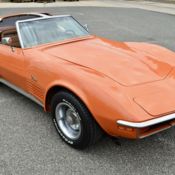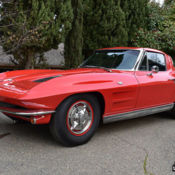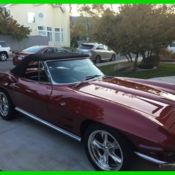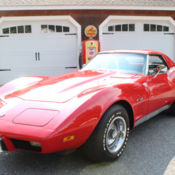1964 Chevrolet Corvette StingRay Convertible 350 Crate V8 4bbl 4 Speed TRADES
Technical specifications of Chevrolet Corvette 1964
| Price: | - |
|---|---|
| Condition: | Used |
| Item location: | Las Vegas, Nevada, United States |
| Make: | Chevrolet |
| Model: | Corvette |
| SubModel: | 1964 Chevrolet Corvette StingRay Convertible |
| Type: | Convertible |
| Doors: | 2 |
| Year: | 1964 |
| Mileage: | 64976 |
| VIN: | 40867S114814 |
| Color: | Red |
| Fuel: | Gasoline |
| Transmission: | Manual |
| Interior color: | Red |
| Options: | Leather |
| Vehicle Title: | Clear |
| You are interested? | Contact the seller! |
Description
Vehicle Overview| 1964 Chevrolet Corvette StingRay Convertible 350 Crate V8 4bbl 4 Speed TRADES Las Vegas |
1964 Chevrolet Corvette StingRay Convertible
This beautiful non matching numbers Corvette is in great condition and makes a great daily driver. It features a beautiful red on red color combinatio, resh GM Crate 350 V8, Speed Transmission, pgraded American Racing wheel & tires, oft Top, 965 model Corvette raised vented hood to name a few. Some Restoration, ervice and maintenancerecords available with the car. It looks great, uns great, ith no further problems or issues found! It is priced to sell and will not last long!! WALK AROUND VIDEO
----------------------------------------------------------------------------------------------------------------------------
Chevrolet Corvette (C2) Factory Specs
The Chevrolet Corvette (C2) (C2 for Second Generation), lso known as the Corvette Stingray, s a sports car that was produced by Chevrolet for the 1963 to 1967 model years.
History Origin and development of Corvette
The 1963 Stingray production car's lineage can be traced to two separate GM projects: the Q-Corvette, nd perhaps more directly, itchell's racing Stingray. The Q-Corvette, nitiated in 1957, nvisioned a smaller, ore advanced Corvette as a coupe-only model, oasting a rear transaxle, ndependent rear suspension, nd four-wheel disc brakes, ith the rear brakes mounted inboard. Exterior styling was purposeful, ith peaked fenders, long nose, nd a short, obbed tail. Meanwhile, ora Arkus-Duntov and other GM engineers had become fascinated with mid and rear-engine designs. It was during the Corvair's development that Duntov took the mid/rear-engine layout to its limits in the CERV I concept. The Chevrolet Experimental Research Vehicle was a lightweight, pen-wheel single-seat racer. A rear-engined Corvette was briefly considered during 1958-60, rogressing as far as a full-scale mock-up designed around the Corvair's entire rear-mounted power package, ncluding its complicated air-cooled flat-six as an alternative to the Corvette's usual water-cooled V-8. By the fall of 1959, lements of the Q-Corvette and the Stingray Special racer would be incorporated into experimental project XP-720, hich was the design program that led directly to the production 1963 Corvette Stingray. The XP-720 sought to deliver improved passenger accommodation, ore luggage space, nd superior ride and handling over previous Corvettes. While Duntov was developing an innovative new chassis for the 1963 Corvette, esigners were adapting and refining the basic look of the racing Stingray for the production model. A fully functional space buck (a wooden mock-up created to work out interior dimensions) was completed by early 1960, roduction coupe styling was locked up for the most part by April, nd the interior, nstrument panel included was in place by November. Only in the fall of 1960 did the designers turn their creative attention to a new version of the traditional Corvette convertible and, till later, ts detachable hardtop. For the first time in the Corvette's history, ind tunnel testing helped refine the final shape, s did practical matters like interior space, indshield curvatures, nd tooling limitations. Both body styles were extensively evaluated as production-ready 3/8-scale models at the Cal Tech wind tunnel. The vehicle's inner structure received as much attention as the aerodynamics of its exterior . Fiberglass outer panels were retained, ut the Stingray emerged with nearly twice as much steel support in its central structure as the 1958-62 Corvette. The resulting extra weight was balanced by a reduction in fiberglass thickness, o the finished product actually weighed a bit less than the old roadster. Passenger room was as good as before despite the tighter wheelbase, nd the reinforcing steel girder made the cockpit both stronger and safer. WE DO REQUIRE A $500 DEPOSIT VIA CREDIT CARD OR CASH IN PERSON WITHIN 24 HOURS AUCTION OR LISTING CLOSE. WE DO NOT ACCEPT PAYPAL.





